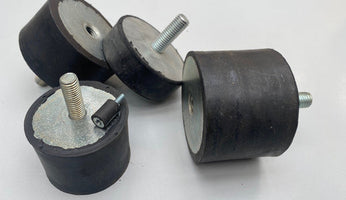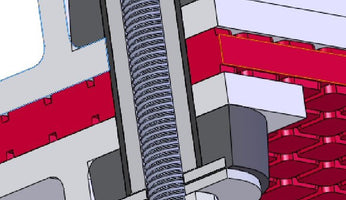What are Track Pads? - An Introduction.
Track pads are also known as Tensioner Pads, Cable-Lay Pads, Pipe-Lay Pads, Chain Tensioner Pads, Track Covers, Trackpads, Tank Pads and Caterpillar Track Pads.
Put simply, they are rubber or polyurethane pads bonded to a backing plate during the moulding process.
For a case study on one of our trackpad projects, click here. We regularly make trackpads which range from 1kg – 15kg each.
What are Track Pads used for?
Caterpillar tracks are most commonly used on excavators, military tanks and other vehicles. They are also found on many types of machinery, especially in the subsea world.
When using Track Pads for vehicle-related applications, the pads are primarily used to prevent or reduce damage to the road surface. They also make the ride a little more comfortable.

Old and new track pads on an M1 Abrams Tank (above) and pads on a Road Maintenance machine, below. (images sourced from Wikipedia)

When used for stationary machinery, Track Pads will normally be used on the 2-4 sets of caterpillar tracks within the machine designed to feed or retrieve pipes, cables or chains. Below is an example of a machine AVMR worked on with Hydraulic Alliance.

This circa 250 tonne machine was designed to push a new water mains pipe 1 - 1.5km down the inside of an old pipe. This saved time, cost and resource when compared to digging a trench.
As the new pipe was relatively fragile, plastic deformation was a risk. If the pipe became oval in its profile threading it down the old pipework would have become much more challenging.
As a result, AVMR conducted friction testing and developed a rubber material which was fit for purpose and offered high coefficients of friction. This machine design had four sets of caterpillar tracks rather than two, as can be seen below, but for more many applications two sets of caterpillar tracks is sufficient.

An individual caterpillar track from this machine can be seen below. Each set of tracks can clamp the pipe with different pressures; the aim is to grip the pipe sufficiently to maintain static friction, but not clamp enough to induce permanent deformation in the pipe.

What are important considerations when designing a Track Pad?
There are a few questions to consider when designing track pads, such as:
- Application: What will the pads be doing and interfacing with (e.g. road, cables etc). If not a vehicle, do you have any understanding of the loads which the item being pushed / pulled by the machine can tolerate?
- Environment: What will the environment be like where the pads are used e.g. Temperature, presence of abrasive materials or foreign objects, interaction with other fluids and gases incl. solvents, oils & chemicals.
- Loading: what pull / push loads are anticipated and what clamping loads have been planned for? How important is an even distribution of load across the interface? Cables and pipes can be damaged if clamping forces exceed thresholds, or if the elastomer does not offer sufficient load distribution.
- Resistance to both wear and tear: High abrasion and tear resistance can be easily achieved but often at the expense of friction. At first sight, this may seem like a balancing act, however other tools and options are available to help us achieve both.
Then there are the basic design questions such as the pad-machine interface, but AVMR prefer to understand the bulleted points first, as the basic design questions are often influenced by them. Note that in the pads on the above image there are no visible mounting holes. This was due to some key aspects of the design, which required a consistent rubber-pipe interface.
What can go wrong with Track Pads?
AVMR have not just manufactured tens of thousands of track pads, we have also tried to keep in touch with customers to understand the performance of our products, and that of other non-AVMR products. It is incredibly easy to make two identical looking products, which perform very differently. Often this comes down to considering the right factors upfront, as above.
The below points are areas we have heard customers, and potential customers, talk about, and are all based on experience:







